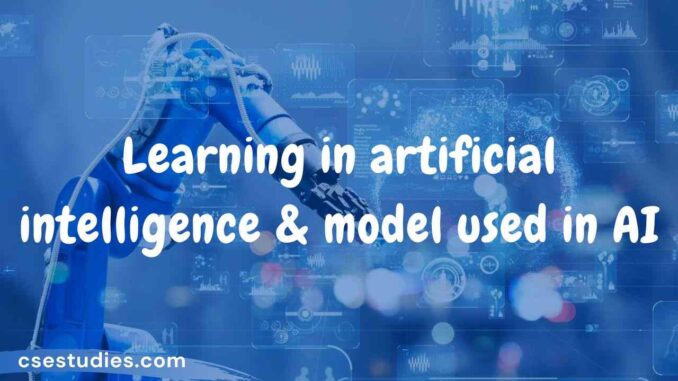
Learning in artificial intelligence refers to the process by which an AI system acquires knowledge, improves its performance, and adapts to its environment based on experience or data. It involves developing algorithms and models that allow AI systems to learn from examples, make predictions, recognize patterns, and make informed decisions without being explicitly programmed for every possible scenario.
There are various learning models used in AI, including:
- Supervised Learning:
- Supervised learning involves training an AI model using labeled examples where both input data and corresponding desired outputs are provided.
- The model learns to generalize from the labeled examples and can make predictions or classify new, unseen data based on the learned patterns.
- Examples of supervised learning algorithms include decision trees, support vector machines (SVM), and neural networks.
- Unsupervised Learning:
- Unsupervised learning aims to find patterns, structures, or relationships in unlabeled data without the presence of explicit feedback.
- The model learns from the inherent structure or statistical properties of the data to identify clusters, anomalies, or other patterns.
- Clustering algorithms, dimensionality reduction techniques (e.g., principal component analysis), and generative models (e.g., Gaussian mixture models) are commonly used in unsupervised learning.
- Reinforcement Learning:
- Reinforcement learning involves an AI agent interacting with an environment and learning through trial and error.
- The agent receives feedback in the form of rewards or penalties based on its actions and learns to optimize its behavior to maximize cumulative rewards.
- Q-learning, policy gradients, and deep reinforcement learning (using neural networks) are popular techniques in reinforcement learning.
- Semi-Supervised Learning:
- Semi-supervised learning is a combination of supervised and unsupervised learning.
- It leverages a small amount of labeled data along with a larger amount of unlabeled data to train a model.
- The model learns from the labeled data while also utilizing the structure or patterns present in the unlabeled data.
- Semi-supervised learning is useful when obtaining labeled data is expensive or time-consuming.
- Transfer Learning:
- Transfer learning involves training a model on one task and then using the learned knowledge to improve performance on a related but different task.
- The pre-trained model’s knowledge is transferred or fine-tuned to the new task, allowing for faster learning or improved performance with limited data.
- Transfer learning is particularly valuable when data is scarce or when training a model from scratch is impractical.
These learning models provide a foundation for AI systems to acquire knowledge, adapt to changing conditions, and make intelligent decisions based on data or experience. Each model has its strengths and limitations, and the choice of learning model depends on the nature of the problem, the availability of labeled data, the desired outcome, and other considerations.
Application of learning in Artificial intelligence
Learning plays a crucial role in various applications of artificial intelligence (AI). Here are some common areas where learning techniques are applied:
- Image and Object Recognition: Learning models, such as convolutional neural networks (CNNs), are used to recognize and classify objects or patterns in images. These models are trained on large datasets to learn visual features and can be applied in areas like facial recognition, object detection, and autonomous driving.
- Natural Language Processing (NLP): Learning models are utilized in NLP tasks such as language translation, sentiment analysis, and text summarization. Techniques like recurrent neural networks (RNNs) and transformer models enable the understanding and generation of human language through training on text corpora.
- Recommendation Systems: Learning algorithms are employed in recommendation systems to provide personalized suggestions to users. These algorithms analyze user behavior, preferences, and historical data to make predictions and suggest relevant items, such as movies, products, or articles.
- Fraud Detection: Learning models are used to detect fraudulent activities in various domains, including finance, e-commerce, and cybersecurity. By learning from past fraudulent patterns and anomalies, these models can identify suspicious transactions or behaviors that deviate from the norm.
- Medical Diagnosis and Healthcare: Learning techniques are applied to analyze medical data, such as patient records, imaging scans, and genomic data. Machine learning models can assist in diagnosing diseases, predicting treatment outcomes, and identifying risk factors.
- Autonomous Systems: Learning is fundamental to the development of autonomous systems, such as self-driving cars and robots. These systems learn from sensor data, real-time feedback, and simulation to navigate environments, recognize objects, and make informed decisions.
- Game Playing: Learning models have been successful in game-playing scenarios. For instance, reinforcement learning has been used to train AI agents to play games like chess, Go, and video games, achieving high levels of performance and even surpassing human expertise.
- Predictive Analytics: Learning algorithms are utilized in predictive analytics to forecast future events or outcomes based on historical data. This includes applications in financial forecasting, weather prediction, demand forecasting, and risk assessment.
- Speech Recognition: Learning models are employed in speech recognition systems to convert spoken language into written text. These models learn from audio data, transcriptions, and language models to improve accuracy and enable voice-controlled interfaces.
- Anomaly Detection: Learning algorithms can identify abnormal or unusual patterns in data, allowing for the detection of anomalies in various domains, including cybersecurity, manufacturing, and infrastructure monitoring.
These are just a few examples of how learning techniques are applied in AI across different domains. Learning enables AI systems to adapt, improve, and make accurate predictions or decisions based on available data, contributing to the development of intelligent and capable systems.